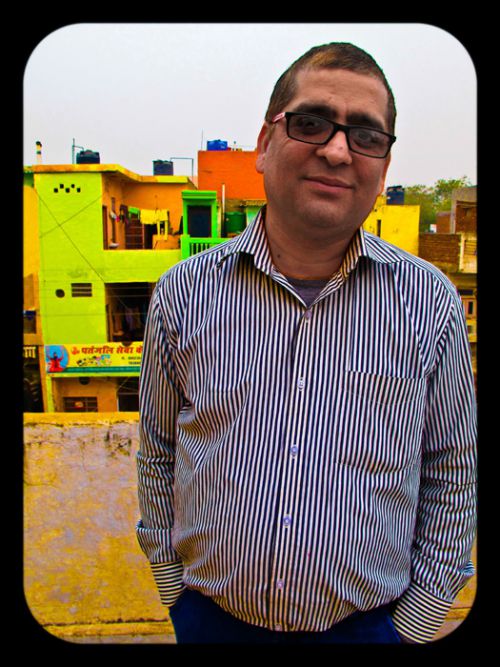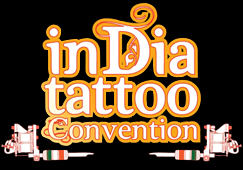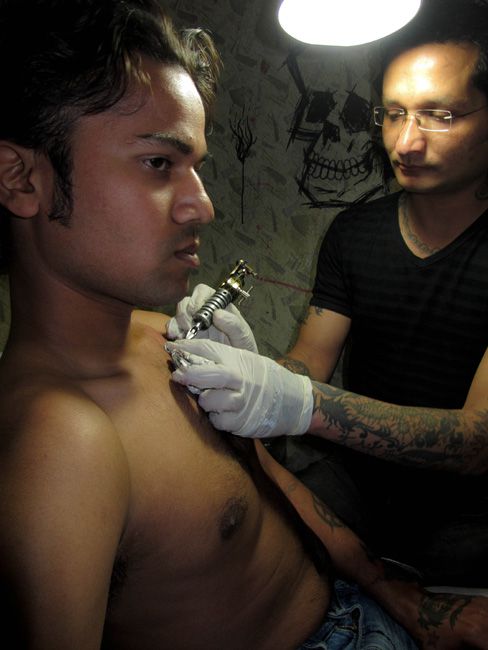15 Interview Bharat Suneja 25/03/2013
Bharat Suneja / Faridabad
Faridabad, Haryana, grande banlieue sud de Delhi, quartier général de Bharat Suneja, initiateur de la Grande : la Convention internationale de tatouage de Delhi.
C’est accompagné de l’inénarrable 4 – Lee que je débarquais dans un quartier résidentiel de la ville où réside Bharat, où se trouve aussi le siège social de sa compagnie, Line Art Tattoo, un des quatre grossistes – distributeurs majeurs qu’héberge l’Inde. En 2011 l’Inde s’éveillait encore quotidiennement sans convention internationale nationale alors que dans ce pays aux multiples ethnies et groupes sociaux la pratique du tatouage est aussi ancestrale que la pensée. Puis le 7 octobre 2011 fut inauguré enfin la première convention, pensée et réalisée par Bharat, suivi d’un petit groupe d’amis fidèles. Bharat en est fier, pas pour les photos et les flash lights, pas pour la renommée, pas pour l’argent, non mais pour l’amour du tatouage «neat & clean» (propre et bien fait).
La première convention fut un gouffre financier mais posa la première pierre d’un bel édifice. La seconde convention fut encore de la poche de Bharat mais le public et les professionnels en firent une belle fête et l’intérêt croissant pour le tatouage en Inde provoqua un afflux improbable qui obligea à fermer les portes le troisième et dernier jour de cette convention. La troisième sera le point de non-retour, sera celle de l’équilibre financier, celle de l’assurance acquise par le travail et une certaine abnégation. Et Bharat, derrière son bureau, s’en réjouit d’avance. Rencontre.
ME : Namaste Bharat (très poli :) En 2011 démarrait une nouvelle aventure qui n’aurait pas eu lieu sans ton concours décisif. Quelles étaient tes intentions précises ?
BHARAT : Mon but est simple, je veux promouvoir l’art du tatouage indien à l’intérieur de nos frontières mais à l’international aussi.
Le tatouage dit « moderne » est un phénomène récent ici, et pas encore si connu. Aucune star dans le domaine, si ce n’est Anil Gupta qui réside aujourd’hui à New York, quelques émissions spécialisées à la télé et de plus en plus de jeunes urbains qui se font tatouer, mais dans le fond ça reste une pratique méconnue, et cela malgré le fait que l’Inde ait de nombreuses communautés tribales qui ont opté depuis longtemps pour l’encrage.
Il y a donc tout un travail de promotion de notre art pour élever le niveau artistiquement mais aussi et surtout pour qu’une pratique hygiénique aux standards internationaux s’instaure en Inde.
ME : Bharat, aujourd’hui quelles sont les requêtes des aficionados du tattoo ?
BHARAT : La grosse majorité des personnes qui se font tatouer aujourd’hui n’ont pas la moindre idée du motif qu’ils désirent, ils demandent à voir des catalogues et des sites internet. Ils se font faire un tattoo parce que c’est une mode, ça fait « cool ». De nombreuses personnes s’en retourneront avec un tatouage de divinité, Ganesh, Shiva, Hanuman, un mantra, un nom, un portrait. Plutôt indien tout de même, mais rien d’ancien. Certaines personnes demandent aussi à se faire reproduire de manière permanente le tatouage éphémère que portait une des stars de Bollywood dans un de leurs blockbusters. Mais malheureusement il y a encore trop peu de demandes personnelles justement « personnelles ». Il faut donc continuer à en parler et éduquer.
ME : Bharat peux-tu me peindre brièvement un tableau du monde du tatouage en Inde ?
BHARAT : Il y a environ 4 ans, ils étaient à peu près 200 à pratiquer le tatouage, aujourd’hui ils sont 3.000 à se réclamer «tatoueur». Plutôt des « scratchers » que des tatoueurs pour la plupart. Les bons sont encore en minorité, et la difficulté à bien se développer provient d’un marché déjà limité où le client ira plus souvent vers un « scratcher » qui ne lui demandera que 10 % de la somme que lui demanderait un tatoueur compétent. Le client se retrouvera avec une marque cutanée mal réalisée et dans des conditions d’hygiène plus que douteuses. Et pendant ce temps-là un bon tatoueur manquera l’occasion de pratiquer et de toujours se perfectionner. Mais il faut bien dire que la plupart des bons tatoueurs font aussi beaucoup de cover-ups (pratique qui consiste à recouvrir un ancien tatouage), et profites donc indirectement de la pratique des mauvais tatoueurs.
ME : On revient sur la genèse de cette convention internationale de Delhi. Vas-y, racontes.
BHARAT : Pendant 5 à 7 années j’y ai pensé, mais à cette époque l’univers du tatouage était microscopique. Seules quelques villes touristiques avaient un studio de tatouage. Mais l’idée demeurait en moi, et après quelques conventions telles que celles de Singapour et surtout celle du Népal, je me dis que cela était aussi possible en Inde et me lançais dans l’aventure. Je contactais alors 4-Lee, puis Jeetu, puis Soni et quelques autres amis, je leur demandais de se joindre à l’aventure et leur dis que je m’occuperai de tout, d’ailleurs j’avais déjà décidé des dates. La première convention internationale de l’Inde se tiendrait les 7, 8 & 9 octobre 2011. Une première convention s’était tenu 6 mois auparavant à Mumbai mais on pourrait la qualifier de « convention locale ».
ME : Et quel est le bilan de ces deux premières conventions ?
BHARAT : Même si au début du projet j’ai reçu en retour beaucoup de propos sceptiques, malgré les obstacles et les pertes, je trouve le bilan plus que positif.
Mes buts sont de promouvoir cet art à un niveau international (que l’on s’intéresse à l’ailleurs, que l’ailleurs s’intéresse à nous et aussi que nous nous intéressions à nous-mêmes), mais également faire de l’éducation en matière d’hygiène. L’autre raison est de présenter de bons artistes à quiconque désire en rencontrer, les regarder et éventuellement passer sous leurs aiguilles. Je peux dire que sous l’impact des médias et d’évènements tel que notre convention la situation évolue, les pions avancent.
Lors de la première convention en 2011 j’ai invité et reçu à 50 % du tarif une soixantaine d’artistes, 30 espaces pour 2 personnes par espace. On a eut environ 2.000 visiteurs et j’ai tout de même été de 15 lakhs de ma poche (environ 22.000 €).
Lors de la deuxième convention, le 5, 6 & 7 octobre 2012, il y avait 50 espaces de 2 personnes ce qui a permis à 100 artistes d’être présents (dont 20 à 25 % d’étrangers, principalement européens : Espagne, Italie, Allemagne, Suède, Suisse ), et que 15.000 visiteurs se sont déplacés pour nous rencontrer, à tel point que le dernier jour j’ai du fermer les portes pour raisons de sécurité. Malgré tout j’ai été encore de 5 lakhs (7.000 €) de ma poche.
Ce qui est étonnant jusqu’à maintenant c’est que les sponsors ne suivent pas, aucun. J’espère que grâce à nos premières expériences acquises ainsi qu’à l’incroyable réseau social Facebook le prochain numéro sera un succès. On espère recevoir 150 artistes dans un nouveau lieu et établir un équilibre financier serait idéal.
ME : Pour toi, quelle serait la prochaine étape nécessaire à une évolution positive de la pratique en Inde ?
BHARAT : C’est le domaine sanitaire qui doit être amélioré. J’espère que la médiatisation aidera à éclairer cette pratique, ses intérêts et ses travers. L’état ou les municipalités doivent prendre leurs responsabilités et imposer un certain nombre de règles. Jusqu’à maintenant c’est le vide total, sauf peut-être dans certains coins touristiques où parfois un papier est demandé, mais personne ne se déplace de toute façon. Et changer ou faire évoluer une loi prend des années ici !!!
ME : Maintenant que tu as bien installé la Convention, as-tu un autre projet ?
BHARAT : Plutôt deux. Le premier est de créer un studio freelance. Tout tatoueur venant ou habitant à New Delhi sera invité à tatouer chez moi dans de bonnes conditions d’hygiène et de confort. Le deuxième projet est la création d’un magazine mais la ligne éditoriale n’a été qu’esquissée. En attendant je dois m’occuper à réaliser la troisième convention, à venir pour le premier semestre 2014. A bientôt alors.
Faridabad, Haryana, southern outskirt of Delhi, headquarter of Bharat Suneja, initiator of the great one : the international tattoo convention of Delhi.
Together with 4-Lee we travelled from Delhi to Faridabad, in a residential area where stays Bharat and his company, Line Art Tattoo, one of the four main wholesellers of tattoo equipments in India. In 2011 India was still awakening without any national « international tattoo convention », even though in this huge country full of tribal ethnic groups the tattoo practice is as old as the thought. And then the 7th of October 2011 was finally inaugurated the first international convention of India, thought and organised by Bharat Suneja and a bunch of his friends. Bharat is proud, not for the photos and the flashlights, not for the fame, not for the money, no but for the love of the tattoo « neat & clean ».
The first convention has been a bankrupt but set the first stone of a nice new event. The second convention was less of a bankrupt but the visitors, the medias and the professionals made a wonderful event out of it and the crowd came in such a number that the third day I had to close the doors for a matter of safety.
The third number will be the one of the no-return, will be the one of the financial balance, the one of the confidence that we got from experiences, from the work and a certain abnegation. And Bharat, behind his desk, looks happy about it. Meeting.
ME : Namaste Bharat (very polite :) In 2011 started a new adventure that would not have happened without you. What were your precise intentions ?
BHARAT : My aim is simple, I want to promote the indian tattoo art within my country but also on an international level. The so-called « modern » tattoo is a recent trend, and is not even so popular yet. No big names excepted Anil Gupta who resides in New-York now, a few TV programms and more and more urban youngsters who get inked, but nevertheless it is still an unknown practice even though we have a long past of tattoo tradition.
So there is a work to do to promote our art in order to increase artistically the level but also and especially for the need of an hygienic practice based on international standards.
ME : Bharat, today what are the main requests from the indian tattoo lovers ?
BHARAT : The big majority who get tattooed today don’t have a clue about what they want to get on their skin, they ask to see catalogues and websites to choose a design. They get inked because it looks nice (me : sometimes!), it’s the trend.
Many people are going for a tattoo of a god, Shiva, Ganesha, Hanuman, for a mantra, a name or a portrait. Rather indian culture still, that’s also what you can get in street tattoo art but of a much lower level of art creation and cleanliness. Some also ask for the non-permanent tattoo they saw in one of the last Bollywood blockbuster, on the muscled arm of Shah Rukh Khan or Salman Khan, the customers just want it permanent. But unfortunately, yet and most of the time, there are not enough of really personal demands linked to interesting meanings. Just cut and paste.
ME : Bharat, can you quickly give us a clue on what is the world of tattoo in India right now ?
BHARAT : About 4 years back, they were about 200 tattoo artists in India, now they are 3.000 to be (or pretend) tattoo artists. Many, very many are rather « scratchers ».
The good ones are still in minority, and one of the major difficulties that they face is the price. As long as a scratcher will ask 10 % of the price that would ask a proper artist, the evolution will take time. The customer ends up with a ugly tattoo on the skin and take a chance to get some diseases but the price is first.
During this time a skilled tattooist will lose a chance to practice more and perfect his art. But the other sign of the time is that these good artists also start doing more and more « cover-ups » as the level rise. So some of them benefit undirectly of these scratchers.
ME : Back on the genesis of this Delhi international tattoo convention. Tell.
BHARAT : During 5 to 7 years I have been thinking about it, but at this time the world of tattoo here was tiny. Only a few touristic places had a tattoo studio. But the idea remainded in me, and after a few conventions as such as Singapore and especially the Nepal one, I told myself that is was time for us, it was possible in India too, and started the adventure. I contacted 4-Lee, then Jeetu and Soni, and a few other friends. I asked them to join in, that I would take care of everything, I already had choosen the dates. The first indian international tattoo convention would be held the 7, 8 & 9 of October 2011. A first convention had been held 6 months before that in Mumbai, but it could be called a « local » convention.
ME : So what are your conclusions on that first two conventions ?
BHARAT : Even if at the beginning of this project I got quite some scepticisms in return, althought many obstacles and loss occured, I find the result more than positive.
My goals are to promote this art on an international level, to promote also safetiness and cleanliness, to present good tattoo artists to anyone willing to know more about the topic and who eventually want to enjoy this day to get inked « live ». I can say that thanks to the medias and events as our convention, the situation goes the right way.
During the first convention in 2011 I invited and also welcome some artists at 50 % of the regular fare. We had 30 booths for 2 people each, so we had about 60 tattoo artists. About 2.000 people came to visit and I still had to spend 15 lakhs (22.000 €) of my pocket.
During the second convention, the 5, 6 & 7 October 2011, there were 50 booths of 2 people each, so we had 100 tattoo artists (20 to 25 % of which were foreigners, mainly europeans : Spain, Italy, Germany, Sweden, Switzerland), and 15.000 visitors came in, so the third day I even had to close the doors for security matters. Even though I still spent 5 lakhs rupees (7.OOO €) of my pocket.
What amazes me is the fact that no sponsor are willing to follow the adventure ?! I hope that now, after the positive results of the past, as well as due to the Facebook web, the next one will be a total success. We hope to have with us 150 tattoo artists in a new place, new sponsors, and getting the balance right moneywise would be perfect.
ME : What would be for you another necessary step in the evolution of this art in India ?
BHARAT : I guess it must be the health matter that must be improved. I hope that the mediatisation will help to enlight the topic, its positive aspects as much as its negative ones. The states and / or municipalities must act and impose a certain number of safety rules. Till now there is nothing, just nothing, maybe excepted in a few towns and touristic spots where a paper is requested even if no officials go and check anything. And to change or create a law in India takes ages ...
ME : Now that you settled well the tattoo convention, do you have a project to come ?
BHARAT : Rather two. The first one is to create a freelance tattoo studio in Delhi. So if any good tattooist pass by Delhi and want to tattoo anyone, he is welcome in my studio with high hygienic and comfort standards. The second project is to create a magazine but the editorial line is still in the blur. Till then I have to start managing the third convention to come, during the first semester of 2014. So see you soon.
CharLee, suivez le lien // Charlee, follow the link
A découvrir aussi
- 01 Inde 2013, plutôt bon début 11/01/2013
- 09 Almora - Uttarakhand 18/02/2013
- 17 ManiKaran - Himachal Pradesh
Inscrivez-vous au blog
Soyez prévenu par email des prochaines mises à jour
Rejoignez les 89 autres membres






